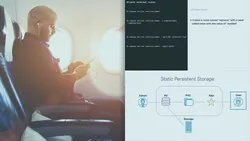
Red Hat Certified Specialist in OpenShift Administration: Configuring Networking and Storage 
This course provides an in-depth look at configuring networking and storage components for the Red Hat Certified Specialist in OpenShift Administration exam (EX280). It covers the necessary skills to effectively manage and configure these components. ▼
ADVERTISEMENT
Course Feature
![]() Cost:
Cost:
Free Trial
![]() Provider:
Provider:
Pluralsight
![]() Certificate:
Certificate:
Paid Certification
![]() Language:
Language:
English
![]() Start Date:
Start Date:
On-Demand
Course Overview
❗The content presented here is sourced directly from Pluralsight platform. For comprehensive course details, including enrollment information, simply click on the 'Go to class' link on our website.
Updated in [February 21st, 2023]
(Please note the following content is from the official provider.)
This course will help you prepare for the EX280 exam by teaching you how to manage and configure networking and storage components.
OpenShift is a Kubernetes-powered platform that allows you to run containerized applications and workloads. In this course, Red Hat Certified Specialist in OpenShift Administration: Configuring Networking and Storage, you'll gain the knowledge required to configure networking and storage components within OpenShift. First, you'll dive into software-defined networking: what it is and how to troubleshoot it. Next, you'll learn how to manage and configure networking components, such as routes, ingresses, and secure routes. Finally, you'll explore OpenShift storage, both persistent and ephemeral, and learn how to configure and manage it. When you're finished with this course, you'll have a better understanding of how storage and networking work within the OpenShift platform as well the capabilities of configuring them to suit your needs.
(Please note that we obtained the following content based on information that users may want to know, such as skills, applicable scenarios, future development, etc., combined with AI tools, and have been manually reviewed)
This course will help learners prepare for the EX280 exam by teaching them how to manage and configure networking and storage components within OpenShift. Learners will gain knowledge on software-defined networking, routes, ingresses, secure routes, persistent and ephemeral storage, and how to configure and manage them.
Possible Development Paths: Learners who complete this course can pursue a career in OpenShift administration, Kubernetes-powered platform engineering, software-defined networking, or cloud computing. They can also pursue further education in related fields such as computer science, software engineering, or cloud computing.
Learning Suggestions: Learners should supplement their learning by exploring related topics such as Kubernetes, containerization, cloud computing, software-defined networking, and storage technologies. They should also practice their skills by setting up and configuring OpenShift clusters and experimenting with different networking and storage configurations.
[Applications]
Upon completion of the Red Hat Certified Specialist in OpenShift Administration: Configuring Networking and Storage course, learners will have a better understanding of how to manage and configure networking and storage components within OpenShift. They will be able to troubleshoot software-defined networking, configure routes, ingresses, and secure routes, and configure and manage persistent and ephemeral storage. Learners will also be able to apply their knowledge to configure networking and storage components to suit their needs.
[Career Paths]
1. OpenShift Administrator: OpenShift Administrators are responsible for managing and configuring OpenShift clusters. They are responsible for deploying and managing applications, configuring networking and storage components, and troubleshooting any issues that arise. As OpenShift continues to grow in popularity, the demand for OpenShift Administrators is expected to increase.
2. Cloud Engineer: Cloud Engineers are responsible for designing, deploying, and managing cloud-based applications and services. They must be knowledgeable in cloud technologies such as OpenShift, Kubernetes, and Docker, and must be able to configure and manage networking and storage components. As cloud computing continues to grow in popularity, the demand for Cloud Engineers is expected to increase.
3. DevOps Engineer: DevOps Engineers are responsible for automating the development, deployment, and management of applications and services. They must be knowledgeable in cloud technologies such as OpenShift, Kubernetes, and Docker, and must be able to configure and manage networking and storage components. As DevOps continues to grow in popularity, the demand for DevOps Engineers is expected to increase.
4. Systems Administrator: Systems Administrators are responsible for managing and maintaining computer systems and networks. They must be knowledgeable in cloud technologies such as OpenShift, Kubernetes, and Docker, and must be able to configure and manage networking and storage components. As cloud computing continues to grow in popularity, the demand for Systems Administrators is expected to increase.
Course Provider

Provider Pluralsight's Stats at AZClass
Pluralsight ranked 16th on the Best Medium Workplaces List.
Pluralsight ranked 20th on the Forbes Cloud 100 list of the top 100 private cloud companies in the world.
Pluralsight Ranked on the Best Workplaces for Women List for the second consecutive year.
AZ Class hope that this free trial Pluralsight course can help your Kubernetes skills no matter in career or in further education. Even if you are only slightly interested, you can take Red Hat Certified Specialist in OpenShift Administration: Configuring Networking and Storage course with confidence!
Discussion and Reviews
0.0 (Based on 0 reviews)
Explore Similar Online Courses

Morning Journaling: Six Prompts for Daily Productivity And Gratitude

Brief Series on Eigenvalue Inequalities

Python for Informatics: Exploring Information

Social Network Analysis

Introduction to Systematic Review and Meta-Analysis

The Analytics Edge

DCO042 - Python For Informatics

Causal Diagrams: Draw Your Assumptions Before Your Conclusions

Whole genome sequencing of bacterial genomes - tools and applications

Kubernetes for Beginners (Kubernetes + Docker)

Scalable Microservices with Kubernetes


Start your review of Red Hat Certified Specialist in OpenShift Administration: Configuring Networking and Storage